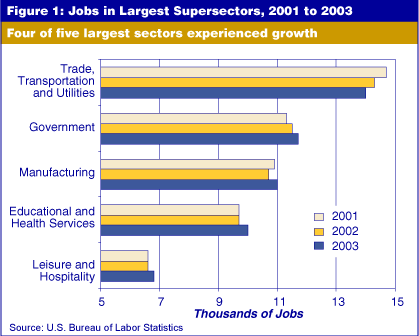Three Views from Terre Haute's Groundhog Day Economic Forecast
The Economist’s Perspective
The national recovery has not yet reached Terre Haute. Indiana State University’s (ISU) Dr. Robert Guell, associate professor of economics, offered a rather glum picture for Terre Haute, citing a Manpower Inc. survey of employer intentions indicating that only 3 percent of local employers were planning to hire in the first quarter of 2004. Meanwhile, 33 percent were likely to scale back on workers.
At the Greater Terre Haute Chamber of Commerce’s 2004 Groundhog Day Economic Forecast on Feb. 2, Guell discussed the commonly held view of Terre Haute as a rundown, union-controlled city, known more for sin and odor than economic prosperity. The city must face these issues head-on and not resort to a quick-fix mentality. Noting ISU’s movement into downtown, the eventual construction of a new Federal Building and the likely raising of the Terre Haute House mean that the downtown area is turning the corner. Citing work stoppage data, he suggested that Terre Haute is one of the least union-controlled cities in Indiana. Beyond changing perceptions, real economic growth could only occur if the city were willing to step up and make opportunities out of its obstacles. Since the EPA will require significant work to the city’s aging wastewater treatment facility anyway, he suggested that Terre Haute invest in a quality scalable system in a new location away from the heavily commercial I-70/US-41 interchange. Such a system would likely bring water-dependent manufacturers and food processors to the city.
The Business Perspective
Luiz Migliora, CEO of CSN, LLC, suggested the U.S. steel industry was in poor shape and that a primary industry in steel was vital to secondary and tertiary steel-using manufacturers. CSN, a Brazilian steel company that purchased Terre Haute’s Heartland Steel in 2001, purchases raw scrap steel and ships more finished products to manufacturers who use it in their end-use products. Migliora suggested that the loss of the primary steel industry— to China in particular—could eventually mean a loss of jobs in secondary facilities such as CSN’s Terre Haute plant and eventually threaten jobs in steel-using manufacturing plants. Whirlpool’s decision to locate a manufacturing facility in China was cited as an example of what will eventually happen if the primary steel industry in the United States is not revitalized.
The State’s Perspective
Lt. Gov. Kathy Davis outlined the steps the governor has taken to prepare Indiana for economic growth. Davis argued that the state’s troubles are tied directly to the overall U.S. economy and that Indiana in particular is ready for the new jobs that a recovery will bring because of the work invested in job training and education. She added that a piece of the economic growth puzzle is changing to Central Daylight Time. Davis relayed a conversation she had with the CEO of an Indiana-based trucking company who described the excess costs and frustrations associated with Indiana’s refusal to observe daylight-saving time. It costs his trucking firm more than $200,000 a year to reprint schedules and make routing adjustments when surrounding states change their time zone and Indiana does not.
Editor’s Note: The Terre Haute metro area has shown a net gain of 400 jobs since 2001, reversing its decline from the previous year. More information on Terre Haute’s economy and demographics is available online at STATS Indiana.

Robert Guell
Associate Professor of Economics, Indiana State University
